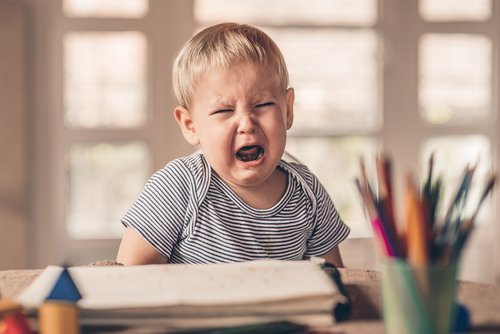3 Psychological Techniques to Calm a Nervous Child Down


Reviewed and approved by the psychologist Sergio De Dios González
Parenting can be complicated at times, especially when your child’s feelings are out of control. If you have a nervous child, you see them suffer and want to do whatever you can to calm them down. To that end, here are 3 effective psychological techniques to calm an agitated, nervous child down.
Psychological techniques to calm children down: some things to consider
- Certain techniques will be more useful than others. It really depends a lot on your own personality, your children’s personality, and the relationship you have with them. That’s why it’s important to try different techniques until you find the ones that work best for you.
- Keeping calm during the whole process is absolutely crucial. If your child is agitated or anxious, they need you to assure them that everything is going to be fine. To help you stay calm, you might want to try deep breathing or meditation for yourself before attempting to calm your child down.
- Keep in mind that any technique, no matter how good, takes patience for it to work correctly. These techniques to reduce your child’s anxiety or agitation are not magic. Sometimes, the emotions will simply be too intense. In those cases, your job is to wait for the storm to pass and be with your child throughout.

Technique No. 1: give it a name
There is a common problem that many children have with their out-of-control emotions. They see them as very powerful and also terrifying. Our first psychological technique is to help defuse the child’s anxiety.
The way this works is quite simple. All you do is ask your child to come up with a silly name for the unpleasant emotions they are feeling. It’s important that the name be as non-threatening as possible.
Once your child finds a name they’re satisfied with, the next step is to order the emotions to leave. For example, if your child decides to call their emotions “Gus,” they could say something like the following:
- Leave me alone, Gus!
- Gus, stop making me feel this way!
By giving their feelings a silly name and talking to them out loud, your child will be taking power away from their emotions. Then, they will be able to calm down much more quickly.
Technique No. 2: listen to your child
When someone tells you about their problems, your first instinct is usually to help them with it. However, that impulse isn’t so helpful when dealing with children. They act less rationally than adults, so using logic to explain that everything is fine doesn’t always work as well as you would think.
Trying to show or explain to a child that nothing bad is really happening might actually make them feel more anxious. Instead, try actively listening to them while you show affection. For example, use physical contact like kisses or hugs. In general, if your child feels listened to and protected, their anxiety will go away almost immediately.

Technique No. 3: give your child a comforting object
A variety of studies show that it’s possible to associate an object with a particular emotion. So if your child has a special stuffed animal or security blanket, for example, use it to your advantage!
Recent studies show that sleeping with a stuffed animal helps children with night terrors. The same principle applies in many other situations. If your child is scared on the first day of school, why not let them take something with them that makes them happy? If the object is small enough, the other children won’t even know they have it.
This technique works even better if you explain to your child what you’re trying to do. Ask them to choose an item that will help them when things are hard. That way, your child will be more involved in the process. The effect will multiply.
Parenting can be complicated at times, especially when your child’s feelings are out of control. If you have a nervous child, you see them suffer and want to do whatever you can to calm them down. To that end, here are 3 effective psychological techniques to calm an agitated, nervous child down.
Psychological techniques to calm children down: some things to consider
- Certain techniques will be more useful than others. It really depends a lot on your own personality, your children’s personality, and the relationship you have with them. That’s why it’s important to try different techniques until you find the ones that work best for you.
- Keeping calm during the whole process is absolutely crucial. If your child is agitated or anxious, they need you to assure them that everything is going to be fine. To help you stay calm, you might want to try deep breathing or meditation for yourself before attempting to calm your child down.
- Keep in mind that any technique, no matter how good, takes patience for it to work correctly. These techniques to reduce your child’s anxiety or agitation are not magic. Sometimes, the emotions will simply be too intense. In those cases, your job is to wait for the storm to pass and be with your child throughout.

Technique No. 1: give it a name
There is a common problem that many children have with their out-of-control emotions. They see them as very powerful and also terrifying. Our first psychological technique is to help defuse the child’s anxiety.
The way this works is quite simple. All you do is ask your child to come up with a silly name for the unpleasant emotions they are feeling. It’s important that the name be as non-threatening as possible.
Once your child finds a name they’re satisfied with, the next step is to order the emotions to leave. For example, if your child decides to call their emotions “Gus,” they could say something like the following:
- Leave me alone, Gus!
- Gus, stop making me feel this way!
By giving their feelings a silly name and talking to them out loud, your child will be taking power away from their emotions. Then, they will be able to calm down much more quickly.
Technique No. 2: listen to your child
When someone tells you about their problems, your first instinct is usually to help them with it. However, that impulse isn’t so helpful when dealing with children. They act less rationally than adults, so using logic to explain that everything is fine doesn’t always work as well as you would think.
Trying to show or explain to a child that nothing bad is really happening might actually make them feel more anxious. Instead, try actively listening to them while you show affection. For example, use physical contact like kisses or hugs. In general, if your child feels listened to and protected, their anxiety will go away almost immediately.

Technique No. 3: give your child a comforting object
A variety of studies show that it’s possible to associate an object with a particular emotion. So if your child has a special stuffed animal or security blanket, for example, use it to your advantage!
Recent studies show that sleeping with a stuffed animal helps children with night terrors. The same principle applies in many other situations. If your child is scared on the first day of school, why not let them take something with them that makes them happy? If the object is small enough, the other children won’t even know they have it.
This technique works even better if you explain to your child what you’re trying to do. Ask them to choose an item that will help them when things are hard. That way, your child will be more involved in the process. The effect will multiply.
All cited sources were thoroughly reviewed by our team to ensure their quality, reliability, currency, and validity. The bibliography of this article was considered reliable and of academic or scientific accuracy.
- Aldana, M. (2009). Los trastornos de ansiedad en niños y adolescentes: particularidades de su presentación clínica. PSIMONART: Revista Cientifica, Instituto Colombiano del Sistema Nervioso, 2(1), 93-101.
- Céspedes, A. (2007). Niños con pataleta, adolescentes desafiantes. Como manejar los trastornos de conducta en los hijos. Ed Vergara, Chile.
- Shapiro, L. E. (2002). La salud emocional de los niños (Vol. 16). Edaf.
This text is provided for informational purposes only and does not replace consultation with a professional. If in doubt, consult your specialist.







